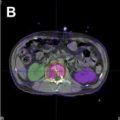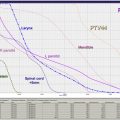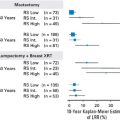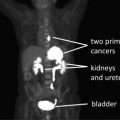Because of the limitations of surgical resection, thermal ablation is commonly used for the treatment of hepatocellular carcinoma and liver metastases. Current methods of ablation can result in marginal recurrences of larger lesions and in tumors located near large vessels. This review presents a novel approach for extending treatment out to the margins where temperatures do not provide complete treatment with ablation alone, by combining thermal ablation with drug-loaded thermosensitive liposomes. A history of the development of thermosensitive liposomes is presented. Clinical trials have shown that the combination of radiofrequency ablation and doxorubicin-loaded thermosensitive liposomes is a promising treatment.
Key points
- •
Limitations of thermal ablation: this article explains available methods for thermal ablation of hepatocellular carcinomas and emphasizes the limitations, including marginal recurrence of large lesions and tumors near large vessels.
- •
Combination therapy for thermal ablation and chemotherapeutics: combining thermal ablation with liposomal drugs such as doxorubicin, which behaves synergistically with heat, has shown improvement in coagulation diameter, drug accumulation, and necrosis.
- •
Thermosensitive liposomes and thermal ablation: development of thermosensitive liposomes has provided a mechanism to combine thermal ablation and drug delivery to maximize drug release at the target site, showing benefits in both preclinical and clinical models.
Introduction
There is a need for therapies that can effectively treat primary hepatocellular carcinoma (HCC) as well as metastases to the liver. HCC is the fifth most common cancer worldwide and the fourth most common cause for cancer death. Metastasis to the liver occurs commonly from primary cancers of the gastrointestinal track and other solid tumors. Surgical resection is an option for less than 30% of patients presenting with metastases. These patients are often not good surgical candidates, because of the location of the tumor or because of intercurrent disease, such as cirrhosis. However, thermal ablation is a cost-effective, nonsurgical option for treatment of patients with HCC and liver metastases and is currently practiced worldwide.
In this review, a new approach is discussed, combining thermal ablation with drug-carrying thermosensitive liposomes. The rationale for this approach is presented and discussed in light of current liposome formulations and methods to achieve thermal ablation. A summary of preclinical and clinical studies that are relevant to treatment of primary and metastatic liver cancer is also presented.
Introduction
There is a need for therapies that can effectively treat primary hepatocellular carcinoma (HCC) as well as metastases to the liver. HCC is the fifth most common cancer worldwide and the fourth most common cause for cancer death. Metastasis to the liver occurs commonly from primary cancers of the gastrointestinal track and other solid tumors. Surgical resection is an option for less than 30% of patients presenting with metastases. These patients are often not good surgical candidates, because of the location of the tumor or because of intercurrent disease, such as cirrhosis. However, thermal ablation is a cost-effective, nonsurgical option for treatment of patients with HCC and liver metastases and is currently practiced worldwide.
In this review, a new approach is discussed, combining thermal ablation with drug-carrying thermosensitive liposomes. The rationale for this approach is presented and discussed in light of current liposome formulations and methods to achieve thermal ablation. A summary of preclinical and clinical studies that are relevant to treatment of primary and metastatic liver cancer is also presented.
Thermal ablation
There are many technologies capable of thermal ablation treatment of focal liver tumors. Power deposition may be localized in a liver target either with externally applied focused ultrasonography or invasively with 1 of several interstitial heating techniques. The underlying physics for 9 interstitial heating modalities has been reviewed previously. Clinical methodology and results from several of those invasive approaches were highlighted in a special issue on thermal ablation therapy of the International Journal of Hyperthermia . For liver tumors, the most common ablative approach involves use of radiofrequency (RF) electrodes inserted percutaneously to the liver target. RF electrodes are available that heat tissue from RF currents between an array of implanted electrodes, along the length of bipolar electrodes, or between implanted electrode(s) and a ground return pad on the skin. Some electrodes include internal cooling to reduce tissue desiccation around the needle, allowing increased power levels and effective treatment volume. To minimize the number of percutaneous insertions and expand the volume of tissue encompassed within an array, RF electrodes are available that deploy multiple tines curving out into surrounding tissue like an umbrella from a central larger electrode.
Although there are fewer clinical systems available, interstitial microwave antennae are increasingly used for thermal ablation of liver tumors, to take advantage of increased penetration of power deposition around each implant. Laser interstitial thermal therapy is also commonly used for liver ablation, with either ultrasound or magnetic resonance (MR) image guidance. Use of high-intensity focused ultrasonography (HIFU) with MR imaging thermometry has also increased for liver ablation in recent years.
Regardless of modality used, power is applied to reach ablative temperatures in the range of 50°C to 100°C. Because of rapid accumulation of lethal thermal dose in this temperature range, ablation generally occurs within minutes. However, this therapy is not without limitations. The risk for marginal recurrence increases when lesions are larger than 3 to 5 cm, and when they are located near large, thermally significant vessels, or visceral organs. In addition, long-term patient follow-up has shown high rates of local tumor progression after RF ablation treatment. Thus, there has been interest in combining thermal ablation with treatments that would augment cytotoxicity at the margin of the ablation zone.
Thermal ablation and chemotherapeutics
Several techniques have been assessed to overcome these limitations of ablation, including the combination of chemotherapy with RF ablation. Many chemotherapeutic agents, including doxorubicin, are known to interact synergistically with hyperthermia, so combining these agents with RF ablation would potentially be effective. For example, Mostafa and colleagues assessed the combination of RF ablation and a chemoembolic mixture, consisting of doxorubicin in iodized oil, in rabbits with hepatic tumors and showed that the combination of local drug delivery and hyperthermia resulted in larger coagulation areas relative to controls.
However, the main dose-limiting factor with chemotherapeutic agents, such as doxorubicin, is normal tissue toxicity, supporting the use of a less toxic liposomal formulation. The first doxorubicin HCl liposome formulation (Doxil, Janssen Products, LP, Horsham, PA, USA), was approved for several clinical indications by equal antitumor activity to free drug combined with reduced cardiotoxicity, which is a dose-limiting organ for free doxorubicin.
Doxorubicin liposome formulation
Liposomes are spontaneously forming lipid bilayer vesicles containing an aqueous medium. They are nanoscale in size, in the range of 1 to a few hundred nanometers in diameter. They can be unilamellar or multilamellar. The most common types are unilamellar formulations, which are formed by passing larger liposomes at high pressure through filters of defined pore diameter or by ultrasonication. Several drugs have been encapsulated into liposomes. For oncologic applications, doxorubicin has been the most widely used drug, because it can be loaded at high concentration. By preloading the liposomes with acid, doxorubicin, which is a weak base, diffuses across the lipid bilayer and reaches such high concentrations inside the liposome that it crystallizes. This review focuses on doxorubicin-containing liposomes, because these are the best-developed formulations and they have been used in clinical trials.
Thermal ablation and liposomal doxorubicin
Several studies have assessed the combination of RF ablation and the nonthermally sensitive liposomal doxorubicin, showing larger ablation zones compared with RF ablation alone, both at the preclinical and clinical levels. Goldberg and colleagues assessed the combination of RF ablation and Doxil in a rat mammary adenocarcinoma model and observed increased coagulation diameter in the solid tumors compared with RF ablation alone, and in a follow-up study, D’Ippolito and colleagues observed a decrease in tumor growth and potential increase in rat survival. In the same tumor model, Ahmed and colleagues reported that the combination of RF ablation and liposomal doxorubicin increased tumor uptake and accumulation of doxorubicin compared with liposomal doxorubicin alone, as well as increased tumor necrosis compared with ablation alone. Ahmed and colleagues also studied the combination of RF ablation followed by liposomal doxorubicin treatment in canine sarcomas, rabbit liver and kidneys, and in the thigh muscle of rats. These investigators observed increased coagulation and doxorubicin accumulation after the combined treatment, showing the effectiveness of this treatment in multiple tissue and tumor types. A clinical study conducted by Goldberg and colleagues treated 10 patients presenting with focal hepatic tumors and showed 25% to 30% greater tumor destruction when liposomal doxorubicin was combined with RF ablation compared with RF ablation alone.
Several mechanisms have been suggested for the synergistic effect of liposomal doxorubicin and RF ablation. Solazzo and colleagues observed increased markers of DNA breakage, oxidative stress, and apoptosis, as well as increased heat-shock protein 70 in the areas surrounding the ablation zone after combination treatment. In addition, the changes in vasculature caused by ablation may affect liposome accumulation within the tumor. Ahmed and colleagues observed increased intratumoral drug uptake and found that less doxorubicin was necessary for tumor destruction after combined RF ablation and Doxil.
Although these studies on the combination of RF ablation and liposomal doxorubicin have shown improvement (ie, increased coagulation and antitumor effect), it has been suggested that optimization is still necessary to improve clinical outcome, particularly if advantage could be taken of the heat produced by ablation. One possible approach is through the use of thermosensitive liposomes, which would take advantage of the more moderate hyperthermic temperatures at the tumor margin, allowing for triggered release of drug at the edge of the heated zone. Gasselhuber and colleagues performed mathematical modeling of drug delivery from low-temperature-sensitive liposomes (LTSL) during RF ablation, which predicted higher drug accumulation with liposomal doxorubicin compared with free drug, as well as lower peak plasma concentration, supporting the use of temperature-sensitive liposomes in combination with RF ablation.
History of thermosensitive liposomes leading to development of second-generation formulations
Dozens of studies have been published combining nonthermally sensitive liposomes with hyperthermia. The rationale for such combinations emanates from the observation that hyperthermia increases vascular pore sizes in tumor microvessels, leading to enhanced extravasation. Although tumor vasculature is typically more permeable to nanoparticles, this enhanced permeability and retention (EPR) effect is substantially increased with hyperthermia treatment. In this review, these studies are not discussed, because when compared head to head, thermally sensitive liposomes achieve higher drug delivery and better antitumor effect. Reviews of previous work with nonthermally sensitive liposomes have been published. Similarly, details of the chemical compositions and physical characterizations of thermosensitive liposomes have been reviewed elsewhere and are not discussed here.
In a frozen state, the liposome membrane contains plates of frozen lipid that interface in a pattern that resembles a soccer ball. When the temperature is increased, the junctions between the frozen plates melt first, leading to enhanced permeability. The liposomes are not destroyed during the melting process; they merely go from a frozen to a melted state. Milton Yatvin was the first to recognize that the enhanced permeability of liposomes to aqueous media near their solid-liquid transition could be harnessed as a drug delivery method if it was combined with local application of heat. The original formulation contained a mixture of 2 lipids of different melting temperatures; it showed a peak in permeability at 45°C. Yatvin and colleagues published several articles with this formulation, showing that it could improve antitumor effect of several drugs, when combined with hyperthermia. Yatvin and colleagues surmised that the increased antitumor effect seen with this formulation was the result of several mechanisms: (1) thermally increased perfusion and EPR, (2) enhanced release of bioavailable drug and (3) enhanced transendothelial drug transport.
Although the principle of thermally mediated drug delivery pioneered by Yatvin was brilliant, the earlier formulations had 3 important limitations:
- 1.
The liposome was readily taken up by the reticuloendothelial system, as opposed to circulating long enough to be efficiently delivered to the heated tumor. The discovery that the circulation time of liposomes could be prolonged considerably by adding polyethylene glycol (PEG) to the surface was a major achievement; these liposomes could circulate for days, thereby maximizing the EPR effect. Gaber and colleagues PEGylated the Yatvin formulation to yield a long circulating thermosensitive liposome. Hyperthermia treatment induced enhanced liposome accumulation in tumors and increased drug release. The combination of these 2 effects enhanced delivery of drug to the tumor by nearly 50-fold, compared with administering the liposomes without heating.
- 2.
The temperature for drug release was too high (43°C–45°C). Typical temperatures that can be achieved in patients without pain or risk of thermal injury are in the range of 40°C to 43°C. Thus, there was a mismatch between what temperatures were achievable clinically and what was needed for maximum drug delivery.
- 3.
The time to reach maximal drug release was too slow (>30 minutes) for routine clinical use. If a liposome entered the heated region and did not extravasate into the tumor, then it would not completely release its contents before the blood containing the liposome exited the tumor. As is shown later, the second-generation thermosensitive liposomes were designed to correct these deficiencies.
Second-generation thermosensitive liposome formulations
David Needham and Mark Dewhirst and colleagues collaborated to develop the first doxorubicin-containing thermosensitive liposome that showed release in the clinically acceptable hyperthermia range. In addition to a mixture of 2 double-chain fatty acids, the formulation contained a small percentage of a single chain fatty acid, known as a lysolipid. It also contained PEG to extend the circulation time. The lysolipid provided for a very rapid drug release (<20 seconds). The maximum release rate temperature was 41.3°C ( Fig. 1 ), but enhanced release occurred over a range from 39.5°C to 42°C. The circulation time was on the order of 2 hours in humans, which is considerably shorter than Doxil, but of sufficient length to work with a typical hyperthermia treatment, which lasts 30 to 60 minutes. The formulation was given the generic term LTSL. In this review, LTSL-Dox is used to represent the doxorubicin-containing formulation, which is the only drug formulation that has been studied extensively with this type of liposome. The generic term for the commercial doxorubicin-containing LTSL is lysothermosensitive liposomal doxorubicin (LTLD).
Other groups have also developed LTSL formulations. Lindner and colleagues described a long circulating formulation that contains a mixture of natural and synthetic lipids. This liposome achieves maximal release at 42°C. This group has extensively studied how plasma proteins affect the stability of LTSLs and has recently reported that the stability is affected by both albumin and IgG, the 2 most common proteins found in plasma. Both proteins tend to lower the temperature dependence of drug release from thermosensitive liposomes. The presence of PEG does not seem to protect the liposomes from these effects. It is important to keep such effects in mind in the engineering of LTSLs so that they still perform to expectation when used clinically. In this case, the goal is to have them maintain drug until heated so that release of drug is maximized in the area receiving hyperthermia.
Dicheva and colleagues have recently reported on a new cationic LTSL formulation. The rationale for this design is based on a different principle than LTSL-Dox. In this case, the goal is to permit intracellular uptake of the cationic liposomes by vascular endothelium and tumor cells, before administration of heat. This concept comes from previous observations that cationic liposomes have a greater affinity for endothelial cells and tumor cells than other types of liposomes. There has been some speculation that damage to vascular endothelium by drug-containing cationic liposomes may lead to ischemia and tumor cell death, independent of any direct tumor cell killing caused by drug delivered by the liposomes. Thus, once accumulated, rapid drug release by intracellular cationic liposomes may achieve high intracellular concentrations of drug, thereby maximizing damage to both the endothelial cell and tumor cell compartments ( Fig. 2 ). This factor is especially important for this approach, because reliance on the EPR effect alone does not yield uniform drug delivery throughout the tumor (also see Fig. 3 ).
Several other investigators have described liposomes containing polymers that show similar drug release characteristics. Thus, there is increasing interest in exploiting this type of drug delivery system.
Preclinical studies with LTSL-Dox
The LTSL-Dox formulation developed by Needham and Dewhirst has been tested extensively at the preclinical level. When FaDu head and neck cancer xenografts were heated to 42°C, LTSL-Dox showed 25-fold greater doxorubicin accumulation in the tumor tissue than free drug-treated tumors. It delivered 5-fold more drug than a Doxil formulation and the PEGylated thermosensitive liposome described by Gaber and colleagues ( Fig. 4 ). Furthermore, the percentage of drug bound to DNA was substantially greater for LTSL-Dox, compared with the other treatment groups. DNA-bound drug is an important end point for this drug, because DNA damage is a primary mechanism for cell death with doxorubicin.









